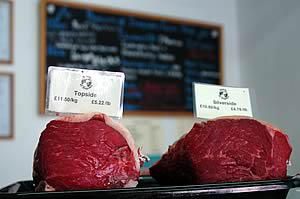24/02/09
The surge in exports that fuelled the 1992-1995 beef sales boom can be repeated if processors put more effort into meeting the shortfall in high quality cuts that is already developing in major beef eating countries like Italy, Spain and France.
This is the view of the National Beef Association which is worried that the major processors, many of whom were pioneers in the development of the UK’s first foray into prime beef exports in the early 1990’s, are concentrating too hard on the home market and missing out on the latest opportunity to take advantage of more sales overseas.
“The current grumble among processors and wholesalers is that the market for high quality steak and striploin is unusually weak because domestic consumers have responded to the recession by focussing their attention on cheaper forequarter cuts and mince,” explained NBA director, Kim Haywood.
“However a combination of short supplies on the Continent, and highly favourable euro-sterling exchange rates, means cuts that are in surplus domestically can be sold at good prices across a range of EU markets instead.”
According to the NBA there is wide acceptance that export demand for UK cow beef will continue to increase but too few companies appear to have spotted the export opportunities that exist for prime beef too.
“No one should have forgotten the time when UK prime cattle averages, led by Northern Ireland, lifted to 240-250p per kilo over 1995 and early 1996 on the back of enthusiastic export demand for young steer and heifer beef,” said Ms Haywood.
The near 26 per cent drop in the value of sterling against the euro since the January 2007 peak is expected to continue for some time because UK interest rates are already wafer thin and the alarming trade deficit in goods and services look likely to continue.”
“Potential beef exporters should also be aware that the export market should be much more profitable than the home market for hindquarter cuts because short supplies are creating much stronger demand for these on the Continent than exists domestically at present.”
“Indeed it could even be argued that the profit advantage for this type of cut already lies with the exporter and the advantages will tip increasingly in his/her favour as the on-going reductions in EU beef production bite further.”
“Countries that were not interested in UK beef last year are actively looking for it now and it is all about balancing product outlets to retain margins. Weak sterling has always fuelled export booms and will do so again – especially as the EU cattle herd is shrinking with each year that passes,” Ms Haywood added.
 Soil Sampling Can Save Huge Amounts of Money Soil Sampling Can Save Huge Amounts of Money
 Charolais Bulls Meet Explosive Trade at Perth Sale Charolais Bulls Meet Explosive Trade at Perth Sale
 Prioritise Rotational Recovery with Spring Cropping Prioritise Rotational Recovery with Spring Cropping
|



